#but no its dwarves a fortress and a drowned city from the first age
Text
Just had a friend ask me what my favorite places in Middle Earth were, fully expecting for me to say something along the lines of Mirkwood, Rivendell, or Lothlorien, and ended up staring at me when I said Erebor, Himring, Khazad-dum, and Gondolin.
#i do not know nearly as much as i should about gondolin but i love the place#nargothrond's close by on this list#fairly certain he expected those response from me because i've been infodumping about pretty elves for the past month#(lotr AND bg3)#but no its dwarves a fortress and a drowned city from the first age#numenor will stay half disowned for rings of power crimes im sorry#lotr#lord of the rings#the silm#the silmarillion#silmarillion#the fall of gondolin#really need to read that but none of the libraries close by have it :(
33 notes
·
View notes
Text
Of the relationship between Mairon and the orcs
An assortment of various of my HCs in one shot format i guess
[This is my first time writing fanfic (whaaat) and i sadly don‘t have an ao3 account yet (but i‘ll get to it once my personal life isn‘t hell anymore) so please consider giving this some love :) ]
Also: this is heavily influenced by @lemurious writing (because all my silm interpretations nowadays are, i just love their content ahh)
His people.
His headstrong, steadfast, steel hard, loyal, ingenious, beautiful people.
When he first came upon them, their bodies had already adapted perfectly to the cold northern tundra of their homeland. Thick grey skin, heavy hair, stocky build.
The wars would add countless scars and burns and limbs of metal.
But that was later.
When he first met his people what was war to them? To him? Who knew then about the horrors they would be forced to face at the hands of the other species of Arda? At a time when they did not even know there were other species.
When he first came upon his people he thought they were the firstborn children Eru had shown the Ainur in their vision. He thought he had been successful in discovering them first, before the other Valar could. He had been so relieved that they would be spared a life in the stifling superficial horror that was Valinor.
And they really are the firstborn. These other, warm skinned, bright eyed, spindly thin creatures that came pouring back from west a couple centuries later, who were they but Valarin lackeys, transformed beyond recognition? And then they demanded land and loyalty and called their primogenitors disfigured and corrupted.
He knows now that he should not have been so surprised back then that these usurpers had shown themselves to have come with the blessing of Illuvatar. After all what were firstborn to Eru? Truly, what had been He Who Arises In Might, the firstborn of the Ainur, what had been his people, the firstborn of his children, to Eru?
The actions of this absentee god would speak clear words in the following millennia, they would come to learn.
When he first came to meet the true firstborn, when he lived among them, when he learned their customs, their language, their love and he found connections so deep they would fuel him for ages to come, that was when he knew he had found his people. And together with their leaders and his own brethren they were able to lay the foundations for a culture that would thrive in spite of its creator and the eternal war this creator perpetuated.
In merely a few centuries, together they were able to develop technologies that would not be seen again the following age.
And then?
The wrath and unquestioned self-righteousness of their enemies erupts over Beleriand and the years of intense warfare lead to brutal massacres. On both sides – he is nowhere close to being without fault; that fierce love of his people has lead him to commit some of the most heinous acts of violence over and over again – but even now he remembers climbing down into the ruins of their underground cities after their defeat. He remembers the protective bunkers filled with civilian bodies and standing in their spilled blood.
The ones that got out in time were mostly soldiers because they had been evacuatable once the defeat was imminent. But the workers, the engineers, the caretakers, the children, those who they had wanted to keep safe in the bunkers? It was too late for them by the time they realises that nothing they could do would stop the fortress from being taken. And then the Valar went on and slaughtered them all.
It is his fault. And at the time it seemed like the worst one he would ever make.
As a nuclear firestorm destroys Beleriand, as the remnants of an entire continent drown in the sea behind them, and he and what is left of his people loose everything, the only thing he can do is lead them away, further and further east. Until he can‘t even do that anymore.
Because at that point everything just collapses in on him. His work has been shattered to pieces, all his brethren and most of his trusted generals killed, his lord, his partner, his lover, his pillar was taken and with that he just stops functioning.
In their hour of greatest need he abandons his people. After all, the only thing he ever seems to bring to them is war and death.
For a millennium he just… There is no purpose, no responsibility. Distantly he hears of the hardships his people are facing now in the East. How slow civilisations develop without the energy of a Vala or three radiating stones to power them. But he shuts it all out. He becomes numb to it.
And strangely, when he stumbles upon the new settlements of the second firstborn he isn‘t filled with unadulterated unstoppable rage. He is just tired. After all, what, truly, are these creatures but the Valar‘s playball in their game of who-is-the-most-despicable-without-realising? And strangely, these Eldar do not recognise who he is.
So why not, he thinks. Why not live in easy expedients for once, why not push away the past and continue to abdicate any responsibility he has to his that people? He crafts a name and a lie to start his new life of ignorance is bliss.
Oh, sweet Tyelpe. How easy it is to share the discoveries they had made in the first age with this ellon when the reward is all eyes big of wonder and desperation to discover more of this „Valinorian“ technology. It is so much like in the old days when he and his brethren and the best scientist of his people would find new methods and formulas to describe the world around them that he can‘t help but loose himself in the intelligent conversations of their workshop, the peaceful thriving of their city, the warm tenderness of their embrace.
They work to create better methods of gaining and storing energy then until they eventually develop the rings that can provide enough power to sustain entire cities.
They plan to make rings for the strongholds of dwarves and men and Eldar. But what about his people, he finds himself thinking. These technologies that are now used in the elvish kingdoms, they are only a small part of what was developed by and for him and his people in the first place. So what about his people?
He feels restless now. Old anger at injustice and blind self-righteousness arise in him again. In secret he starts travelling to the settlements his people have made in a country they call Mordor. The conditions there are rough and the technology now primitive compared to their glorious past but he sees a lot of recent progress.
All of the generals and leaders of old are long dead now and it takes a lot of time and effort to convince his people to trust him again, that he can and will help and that he won‘t abandon them again. They start building an underground city and a fortress once more, Barad-dûr, where the energy will be harvested. He creates a ring more powerful than any of the ones before. It has to supply the entire population after all.
When he returns to Eregion something has changed.
He can feel a strange charge in the air. Are the Eldar suspecting something? They all seem very worried at the sudden surge of activity in Mordor and he is starkly reminded that these Eldar, at the end of the day they still view his people as an ultimate but also undignified threat.
He knows something is wrong when Tyelpe suggests that their rings might also be used as a weapon. One of mass destruction. Mass destruction of his people that is. Tyelpe leaves that unsaid but it is clear as day what he means.
He doesn‘t need to worry about the rings for the elven cities anymore, Tyelpe tells him then and smiles.
A primordial fear settles into his bones. The horror at what is to come turns his stomach. What has he done? How could he have given all this help, all this power to the Eldar when they would only turn around and use it against his people?
He remembers sitting outside on some steps, pulling at his hair, his entire body shaking, growing increasingly mad at all the options that seem to slip out his hands one by one. And when Tyelpe comes to meet him there the only thing left for him to do is to push the ellon against a pillar, knife to his eye and demand the elvish rings he devised in secret. But Tyelpe laughs bitterly and spits in his face.
So it is truly you, the abhorred one, the dark foe‘s torturer, his whore.
This time it is his own wrath that razes cities to the ground. His people are ready for war. They have to be. And the next centuries are dictated by mindless destruction and production lines of battle machinery being the first thing that is re-introduced into the city of his people.
But still the population grows again, the conditions improve, their underground civilisation expands and he finds that he can make alliances with some of the human tribes and kingdoms that they had given rings of power to.
He and his people once again find ways to live in perfect symbiosis with the harsh climate of their land. Volcanic soil is fertile, air and water can be filtered and the ring offers them enough power to sustain artificial lights for growing crops underground and more.
It‘s progress but one that they keep secret. Because just like he is fuelled by the fear of elvish development, the Eldar would surely bring about another war of wrath if they knew about the advancements of his people.
The whole Numenorean ordeal that followed some centuries later was a mess. When that conquerer-king and his armies march upon Mordor he has no choice but to give in quickly. They cannot risk being invaded. Luckily these men are self-complacent enough to take their smugness and their ‚victory‘ and leave again. Though they also feel the need to drag him to that forsaken island of theirs.
Ar-Pharazon truly was a conquerer. He stretched his hands further and further for more colonies on the continent while his nation corroded away with by civil war. The golden king took and took from everyone around him and the displays of subjugation he was continually forced to perform to this king were manifold and in all kinds of ways.
Of course the wrath of the Valar that they unleashed upon the island as soon as they felt slightly threatened in their superiority was in the end blamed on him. He only ever indulged the Numenoreans‘ fantasies. When they brought him to their island it was already on the brink of collapse with conflict and misanthropic ideologies. Sure he, too, lost himself a bit in that collective insanity; he was complicit, so was everyone else. And then Eru felt they could cast judgement upon all these individuals and drowned yet another continent.
He laughs in the face of such insolence. It‘s hysterical, maybe more so a scream.
Then the water hits his body. It presses all the air out, breaks his ribs, crushes his lungs.
When he awakes again he is floating on a piece of driftwood, endless blue stretches around him. His body is raw and for some reason he finds himself unable to shift form anymore. He starts to panic, tries to force his particles to regroup in a way that forms a bird, a fish, something, he needs to get out of this blue emptiness now, he needs to – what is happening??
There is another war at the end of that age, but by that time his memory has turned into an indecipherable blur. It leads to yet more massacre. But worst of all, they take the ring.
For him it is as if all the tissue that holds him together suddenly loosens. He falls to his knees, sacks into himself. He can feel his spirit oozing out of the leaks that now penetrate his form. He stumbles back.
In the underground city the lights go dark, the industrial production comes to a standstill, the water and air filters turn off. His people pour out of their homes once they start to starve, once they realise that their military has lost the war and that their government has no way of dealing with the catastrophe.
They are in need but once again he is abandoning them. He is just so tired.
In the tower there is a large tank with cooling liquid for the energy production of the ring that he now lies in. In the pitch-black darkness his bones have started to shine with a dim fluorescent green. His body has started to disintegrate.
Outside he can feel the remnants of his peoples civilisation fall to ruin a second time. It takes only a few decades for them to return to the primitive conditions of their life without a secure energy supply.
And then suddenly it‘s not only his body that disintegrates anymore but the heavy elements in him too. At a faster rate than is normally used to power an Ainu‘s body that is. The heat of the nuclear fission that has set in brings the coolant to the boil and he had just barely enough mind and willpower left to set off the steam turbine. With a thudding noise the whole energy plant slowly comes to life again.
And for the next millennia Mairon lies submerged in the coolant tank, his body glowing and radiating and falling apart, his atoms splitting and powering a city that has been abandoned and he can only hope that his people will come back and reclaim what is theirs by right and rebuild their lives, their culture, their technology with the last energy that he has to give.
#How Mairon turns himself into an atomic reactor: a powerpoint with pictures#sci fi tolkien#silmarillion#tolkien#mairon#orcs#lotr#silmarillion fanfiction#fanfic#technology#science in tolkien#sauron
15 notes
·
View notes
Text
Amazon LotR Map Analysis
Unfortunately the LotR fandom, Silmarillion fandom, and general Tolkien fandom on Tumblr has seemed either entirely uninterested in this show, or openly hostile to it ever since its announcement. This, to me, is a shame, since the involvement of the Tolkien Estate, together with the learning experiences of the critically panned Hobbit trilogy and the immense budget given to this show all point to a series of good quality and impressive visuals. At the very worst case, we will get to see more Middle-earth on screen, and I for one am thrilled at that prospect.
Anyway, today marked the end of the long and emotionally fraught series of maps released by the “Lord of the Rings on Prime” account on their Twitter, Instagram, and Facebook. Through the whole process, many theories have been going around as to the meanings of the various maps, speculations on the inclusions of certain names, and so forth. Now that we have reached the apparent end of the map releases (since the Ring verse they’ve been accompanied by has been completed), it seems a good time for me to analyze the map in its final form, as well as any pertinent details from the previous incarnations that might appear striking. I’ll break the map down into sections to make it easier to go through all the details.
Without further ado, let’s begin!
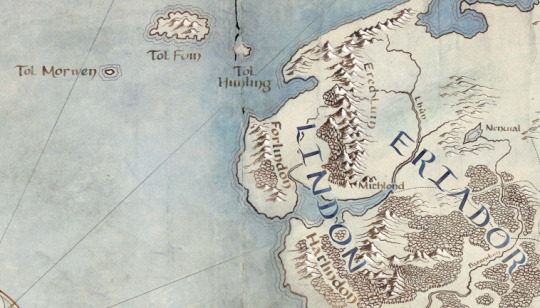
First thing I noticed was the addition of the Western Isles, Tol Morwen, Tol Fuin, and Tol Himling. Some brief lore discussion:
Tol Morwen: This island marks the grave of Túrin Turambar, Niënor Níniel, and Morwen Edhelwen. The Stone of the Hapless, or the Talbor (in Taliska) was the grave marker made for them by the people of Haleth, and was prophesied by Glirhuin the bard to remain standing even if the waves drowned the land, as indeed after befell.
Tol Fuin: This island is the remains of the pine clad heights of Dorthonion, where the people of Bëor dwelt in their land of Ladros. The most interesting facet of its inclusion on this map is that it only appears in The Unfinished Tales, and is not part of any map published along with Lord of the Rings or the Hobbit. This has some interesting implications, as we will discuss later.
Tol Himling: This island is the height where Maedhros had his city and fortress of Himring in the First Age, which was destroyed by Morgoth during their long war. It remains above the sea after the flooding caused by the War of Wrath.
The rest of this section is nothing too new, but there is one minor feature that caught my eye. The hills next to the names Forlindon and Harlindon were not present on any previous version of the map, nor are they present in any published Tolkien map. As we will see later when we examine the land where Gondor will come to be, he coastline is changed there. Both of these are connected, I think, to the fact that this map is in the Second Age, before the Downfall of Númenor. In this time the world was flat, but after the Cataclysm, the flooding caused by the destruction of the island led to great changes in the coastlines of Middle-earth, and I think these hills reflect the prior state of the coast.
Nenuil is included, which may indicate the possible presence of the native men of Eriador, who first met the Númenóreans in the hills to the north of the lake.
The inclusion of the names Lindon, Harlindon, Forlindon, and Mithlond all point to the inclusion of Gil-galad’s kingdom of Lindon in the series, which was the last and largest High-Elven kingdom in the Second Age.
The Ered Luin, Lhûn and Baranduin (Brandywine) are also named, but this is most likely just an indicator that the general region of Eriador will be a setting for the show.

This is a very exciting portion of the map! A lot of information is conveyed by the names here, so let’s break it down.
Eregion was the Noldorin realm founded by Galadriel and Celebrimbor, where the Rings of Power were eventually forged. Ost-in-Edhil was the capital city. Curiously, on this map, Ost-in-Edhil is moved from it’s canon location and placed where the city of Tharbad is meant to be. This may simply be a choice on the part of the showrunners to give Ost-in-Edhil a more interesting location by placing it next to the marshes of Nîn-in-Eilph, the Swanfleet, but at this point we can’t know for sure. Regardless, the inclusion of these names, including the Glanduin and Gwathló rivers, points very strongly to the setting of the show being during or before the forging of the Rings of Power in SA 1600, as Eregion was destroyed soon afterwards.
The Bruinen and the Mitheithel are named, but pointedly Imladris is absent from the location where it was on the previous iterations of the map. This indicates also that the show takes place during or before the forging of the Rings of Power, since Imladris was founded in the following war.
Khazad-dûm is also named, as well as the three mountains Fanhuidhol, Celebdil, and Caradhras which rise above it. Together with the Celebrant river and the valley of Nanduhirion (Azanulbizar in Khûzdul), these names suggest the inclusion of the Dwarves of Moria, or Hadhodhrond as it was called by the Elves in those days. The name Lórinand is also given, which was the name of the kingdom of Silvan Elves ruled by the Sindarin King Amdír. There are excellent meta-analyses of the source texts in existence that show his friendship with the Dwarves of Hadhodhrond was quite strong, which is strange for a Sindarin Elf.
Ninglor and the Hithaeglir and the Anduin are named, but I cannot see any hints there beyond the simple fact that they were around at that time, although the inclusion of the Ninglor (Gladden) is odd.
The North-South road later called the Greenway is present on this map, which is odd to me. I had always thought the road was built to connect Gondor and Arnor together, but since this is before they were founded, I am unsure why it is included. It ends where Fornost will be one day, but currently it is blank. Will we see a new settlement of Men in this place? Perhaps the center of the native Eriador civilization encountered by the Númenóreans?
Lond Daer is included on this map, which lets us know that the show must take place after SA 750/800 when that haven was created by Aldarion the crown prince of Númenor as a source of lumber and supplies for the fleets.
Speaking of lumber, this brings us to the last feature in the section we can comment on: the forests!! The entirety of Minhiriath (Land Between the Rivers) and Enedwaith (Middle-Folk) is covered in trees, and we learn from The Unfinished Tales that many Men dwelt there at this time, some of whom were wary of the Númenóreans due to their logging of the forest. In fact, in later years, the logging grew so bad that the Men were driven out of the lands and took refuge in the last remnants of the forests, most prominent of which was Eryn Vorn, the Dark Forest, which is also included on this map. Perhaps we will see a settlement of these Men here in the show?
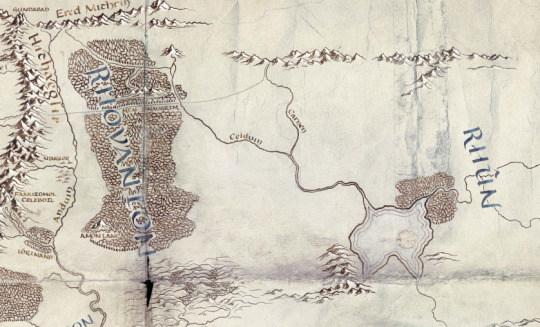
This section was sadly left very unnamed, but there are still plenty of tidbits here!
Gundabad is named, which functioned as the Awakening Place of Durin I, and was considered a sacred place to the Long-beard Dwarves. However, after the War of Wrath, Orcs came fleeing into the northern mountains, and they took it to the Dwarves dismay. Could we see this in the show?
The Men-i-Naugrim, the Old Dwarf Road, is also marked on its way through Mirkwood. However, they add an extension of the road leading all the way to the Iron Hills, which has never been included on any Tolkien map to date. The Long-beards founded their settlement in the Iron Hills in either the First or Second Ages, so I am unsure why it is not labeled here.
Amon Lanc is named on the map, which implies the inclusion of the Silvan Realm of Mirkwood. In the early Second Age, the Silvan Elves of Mirkwood lived across the river from their kin in Lórinand, dwelling about the slopes of Amon Lanc, the Bald Hill, later site of Dol Guldur. Their king was Oropher the father of Thranduil, a Sindarin Elf, who later died in the Last Alliance.
The terrain in this region is interesting in several respects. Firstly, the East Bight in Mirkwood has been filled in, since it was in fact not in existence until the Third Age when it was felled by the Northmen who lived there. Celduin and Carnen are named, but the significance of this is unclear. The most interesting feature of the terrain, however, is the inclusion of a series of forested hills across the Anduin from Fangorn. These occupy the later area of the Brown Lands, and in we learn from Treebeard that this land was once the Gardens of the Entwives, until the war of the Last Alliance when Sauron burned them brown. He says that Men lived near the Entwives and learned agriculture from them. It is unclear if we will see Entwives in the show, or if they are simply presenting a more accurate terrain map for the Second Age.
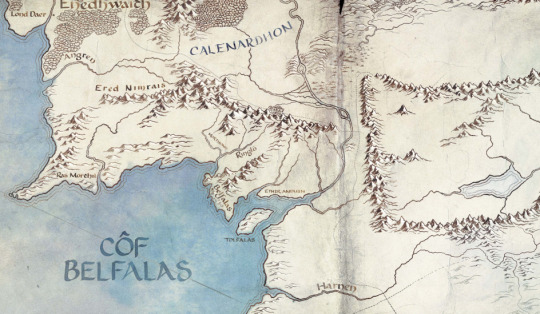
This is another relatively empty map section. However, there are some definite points of interest. Ethir Anduin, Belfalas, Tolfalas, Morthond, Ringló, and Ras Morthil are all geographical areas and features of Gondor, but I am unsure if they have any significance. Ras Morthil is particularly odd, since it is a very obscure place about which we know next to nothing. Drúedain were said to live there, so perhaps we will see them? There is a later unfinished story Tolkien wrote called Tal-Elmar, where the Númenóreans are seen from the perspective of native people living near the mouths of a river in Gondor. Perhaps we will see such a story?
Of particular note is the shape of the coastline. The Anduin does not have a delta, and the coastline is much smaller here than it is on Third Age maps. This is consistent with the lore for the effects of the flooding post-Cataclysm.
Mordor is devoid of names, suggesting that Barad-dûr is not yet built.
The last interesting thing here is the name Côf Belfalas (Bay of Belfalas) which is a name that only occurs in the very very obscure essay by Tolkien titled The Rivers and Beacon Hills of Gondor. It was never published by Christopher Tolkien, and appeared only in the linguistic journal the Vinyar Tengwar. The fact that this name is included here suggests that the rights the show has are far greater than we had previously thought.

This section is the most new, as well as the least informative. Much terrain has been added, but it is faded quite a lot compared to the rest of the map, and I am unsure what this signifies. Khand is still included, which is very interesting to me. Perhaps we will see these empty areas filled out in a later promotion? So far there have been no new names or made-up named locations, so perhaps they are simply saving them for a later date? Regardless, the possibilities here are virtually endless.
Umbar is interesting in that the city is not marked on the map. We do not have a precise canon date for its founding, but it is odd that it would not be in existence at this time. Even more odd, however, is the fact that a heretofore unknown road is shown leading to its very site, and then off east towards Khand. Perhaps this whole area will be expanded upon at a later date?
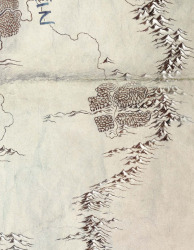
This part of the map is only worth commenting on because it is entirely new in terms of the established maps for the Second and Third Ages. In some hasty maps of the First Age, Tolkien shows an eastern range, the Orocarni (Red Mountains) in the east, but it seems that they were further east than these. The identity of these mountains remains a mystery, as we have no new names to speculate with. Perhaps they will also gain some depth.
For the East and South there is the possibility that we will see the Blue Wizards. In Tolkien’s latest notes on the Istari, he said that the Blue Wizards came with Glorfindel in the Second Age around the year 1600, and were instrumental in disrupting Sauron’s plans in the East and South. Perhaps we will see this in the show?
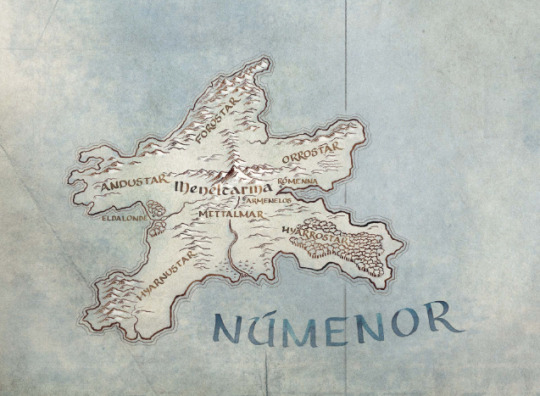
And finally, we have arrived at the most exciting portion of the map: Númenor itself! The island is filled in with all the major names from the Unfinished Tales map, and features all the terrain details we expect. However, its inclusion, along with Tol Fuin from earlier, proves that the show has the rights to The Unfinished Tales, and if the elvish for the Bay of Belfalas is to be believed, it means they have the rights to even more.
So what does all of this mean? Well, based on the dates, there is only one significant global event during the time from SA800-SA1600: the forging of the Rings of Power. All the names for all the places we’d expect to see are present, and many different arenas are included on the map for a truly global showcase of the time. This could include the forging itself, the leadup to it including the political tensions between Galadriel and Celebrimbor and the arrival of Sauron disguised as Annatar, and the War of the Elves and Sauron following after. This war saw the death of Celebrimbor, the creation of Imladris, and the full might of the Númenórean navy.
This will, in my opinion, make for a fun, diverse, and complex show with many different perspectives and characters and races all competing together, as well as the familiar faces and ties to LotR that the show needs to gain popularity with movie fans. Then there’s this:
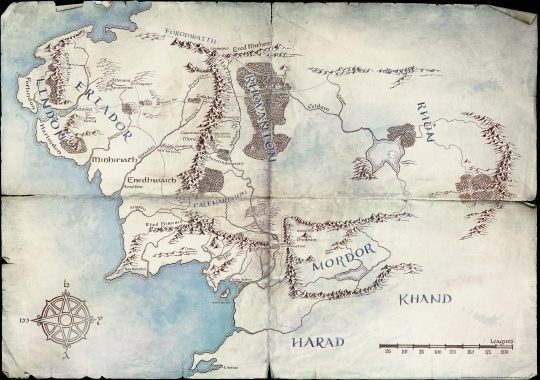
The second-to last map the account released. The inclusion of Arnorian cities like Annuminas and Fornost, as well as Gondorian places like Osgiliath and Minas Anor and Minas Ithil, suggest that the map is teasing the Last Alliance. Perhaps, as has been rumored, the show will be an anthology series, spanning the Forging of the Rings to the Last Alliance. If so, that will be an ambitious project, and one I look forward to with excitement and hope.
#meta#analysis#map#lotronprime#amazonlotr#fandom#lotr#silmarillion#rant#please excuse my absurdly long post#i really wanted to get all of this out.
152 notes
·
View notes